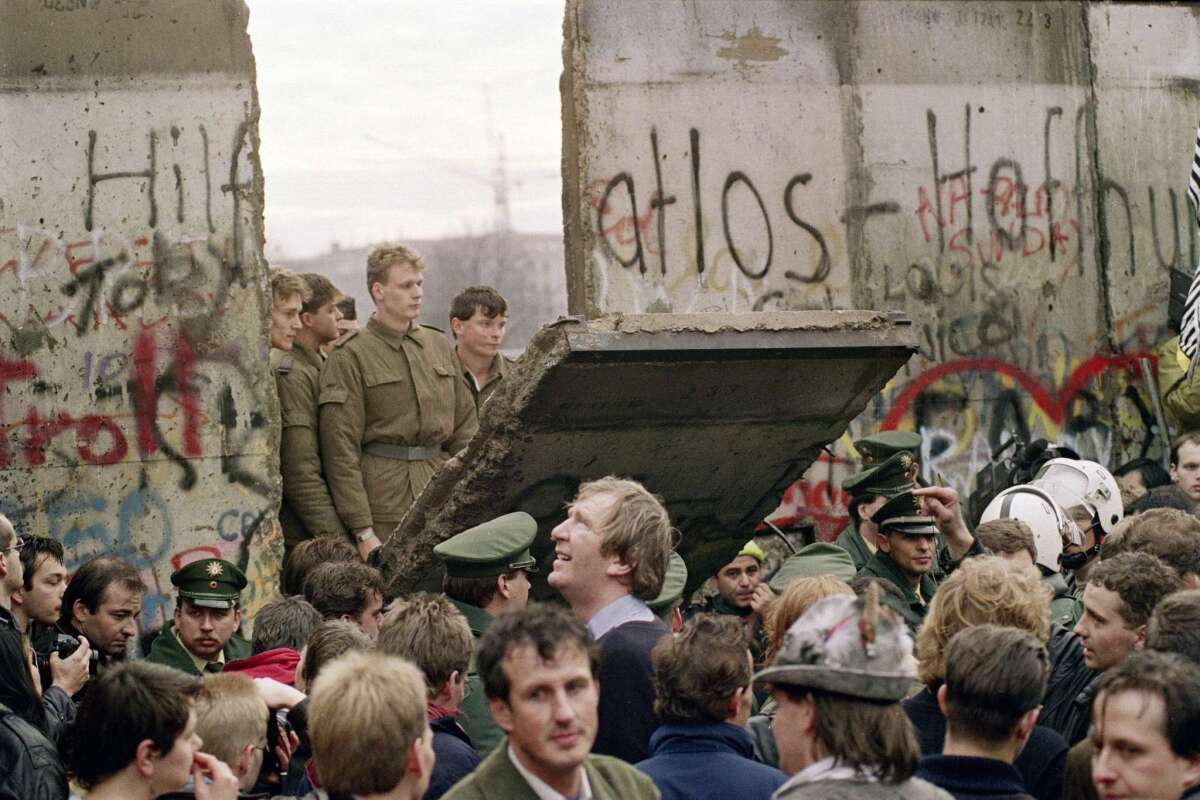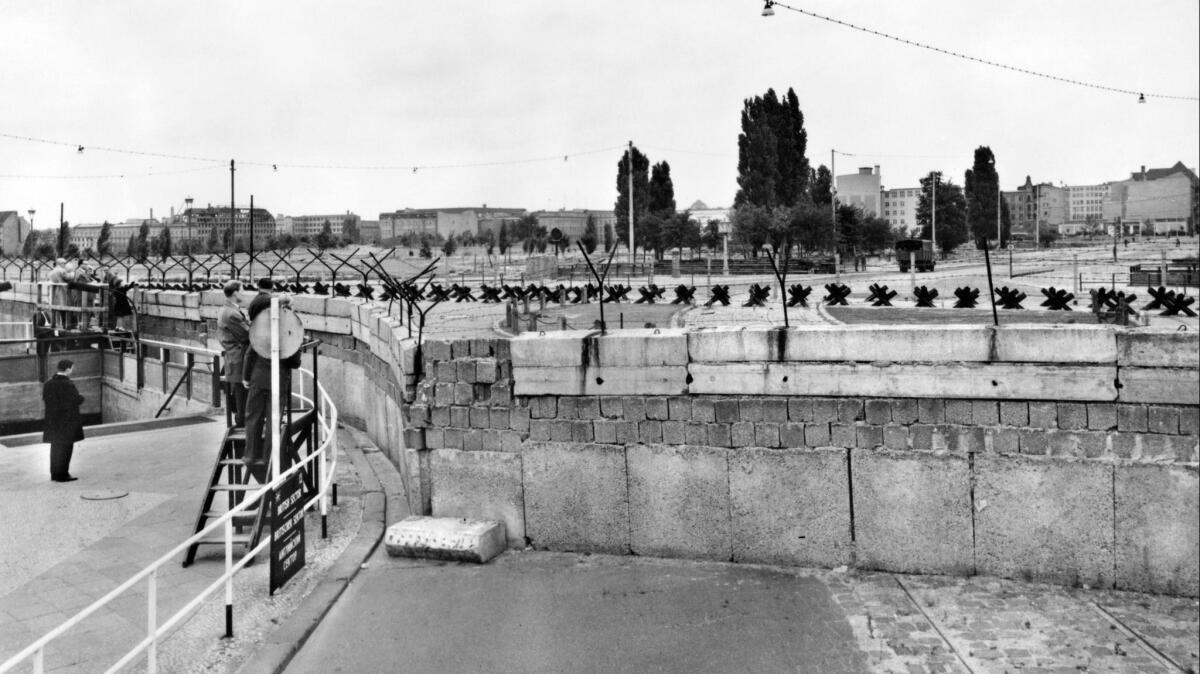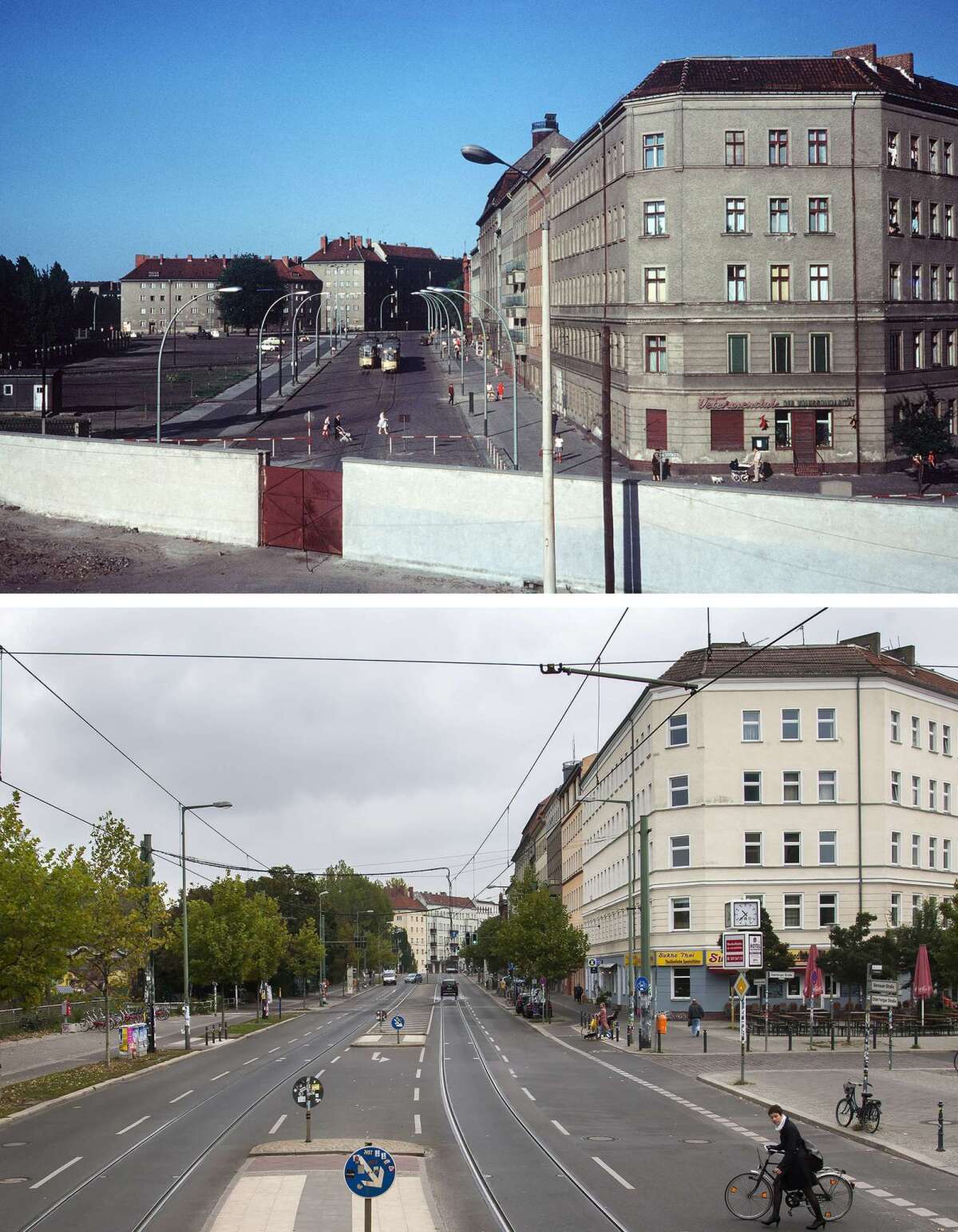Perspective: What the dismantling of the Berlin Wall can teach us as Trump tries to build his wall

Reporting from Venice, Italy — In 1962, two men from East Berlin attempted a daring escape to the West. Peter Fechter and Helmut Kulbeik were young — all of 18. On Aug. 17, the pair slipped away from their construction jobs during their lunch break and made their way to the border, hiding in an old factory near the Checkpoint Charlie crossing of the Berlin Wall, which had been erected only the year before.
Around 2 p.m., they slipped out an open window into the barbed wire-filled no man’s land alongside the wall. They then made a run for it. Kulbeik managed to scramble over the wall, then still a crude barrier not much taller than a man.
For the record:
12:00 p.m. June 27, 2018An article about a German exhibition called “Unbuilding Walls” at the 2018 Venice (Italy) Architecture Biennale said it features video testimonials gathered by architects at border walls around the world, including Israel and Palestine. It should have said Palestinian territories.
Fechter did not.
An East German guard shot him before he could make the climb. His body fell to the East, but was visible in the West, from the windows of buildings close to the wall. He cried for help, but no guards or medics came. In full view of the world, he bled to death. On the Western side of the wall, a crowd of hundreds gathered and chanted “murderers” at the East German guards. The security zone in which he died became known as the “death strip.”
After Fechter’s killing, it seemed beyond the realm of imagination that the Berlin Wall could ever come down. Yet, less than three decades later, it did: In November 1989, after a member of the East German Politburo announced that restrictions on travel would be lifted, East Germans flooded the border, and joined by West Berliners on the other side, tore the wall apart with whatever tools they could find. Within months, this seemingly intractable political barrier had crumbled. By the following year, Germany was one again.
The wall and its physical and political aftermath are at the heart of one of the most captivating pavilions at the 2018 Venice Architecture Biennale, on view through Nov. 25. In keeping with the biennale’s “Freespace” theme, “Unbuilding Walls,” as Germany’s exhibition is titled, charts the ways in which architects and urbanists have sought to weave back together East and West since 1989 — both physically and psychologically.
Step into the German pavilion and you are greeted by a grim black wall bisecting the room before you. Walk farther into the space, however, and the wall appears to fragment. The long, black barrier, it turns out, isn’t solid. It is a series of unconnected vertical slabs, laid out at different depths, that provide a passing illusion of fortitude. It could not be more sculptural.
It also could not be a more propitious time for this show.
This year, Feb. 5 marked the day that the wall had been gone as long as it had been up — 10,316 days. The wall, as the curators note in a related essay, “represented not only the division of a city and the division of an entire country” but also became a symbol of “state repression, forcible separation, autocratic despotism and the inhuman potential of political ideology.”
Moreover, the deconstruction of the Berlin Wall and its attendant Cold War legacies highlights the construction of walls elsewhere — such as the “big, fat, beautiful wall” President Trump wants for the U.S.-Mexico border — and points to a future in which those walls may be no more.
Architect Lars Krückeberg is a founder of the Berlin-based design studio Graft and served as a curator of the exhibition. He says that growing up in Germany — in the West — the wall seemed like it would always be a part of the landscape.
“If you had asked me in Germany, even half a year before it did, will that wall come down?” he says. “I would have have said, ‘No. It can’t come down.’ And a lot of people would have said that.”
Today, tourists flood sites such as Checkpoint Charlie, the wall’s most recognizable crossing point, to have their pictures taken with actors in military costume.
Walls that go up, one day come down.
Krückeberg organized the exhibition with his fellow Graft founders Wolfram Putz and Thomas Willemeit, in collaboration with Marianne Birthler, a human rights advocate who served on a commission that investigated the crimes of the Stasi, the East German secret police.
“There have been many stories in exhibitions about the wall,” Krückeberg says of the impetus for the show. “But there have been no exhibitions that look at the space around it — a space that could be very deep.”

You can’t just divide things. If you do, you’re cutting through tissue. And you damage and you hurt and you scar. We know that from Berlin.
— Lars Krückeberg, architect
Together, the curators have put together a dense but fascinating show — with an essential (and blessedly well-written) catalog that looks at the urban and rural sites occupied by the Berlin Wall before, during and after its existence.
As part of this, they recount riveting bits of the Berlin Wall’s urban history.
The wall, for example, cut indiscriminately across existing rail lines, but subterranean rails were left untouched. This meant that West Berlin underground lines regularly crossed into Eastern territory as part of their daily routes. To observe the political boundaries, however, Western trains didn’t stop in on the Eastern side, resulting in a number of ghost stations. Except for one: Friedrichstrasse, which served as an official border crossing, and which was dubbed the “Palace of Tears,” since it’s where easterners said goodbye to friends and family heading back to the West.
There is the long history of Potsdamer Platz, a busy intersection of traffic and trams — once home to Europe’s first traffic lights — that was bombed to rubble during World War II and was later unsympathetically divided by the wall. And there was the Gothic Revival church from the 19th century that was blown up in 1985 because it had the misfortune of being in the middle of the death strip. (At this spot now stands the Chapel of Reconciliation, designed by Sassenroth & Reitermann, that is built on the foundations of the earlier church.)
“Unbuilding Walls” reviews the myriad architecture and urbanism projects that have arisen as a reaction to the Berlin Wall — such as the Band des Bundes, a strip of federal buildings designed by German architects Axel Schultes and Charlotte Frank that seem to strap together East and West like the buckle of a belt. The show also reviews the parks and monuments that incorporate elements of the wall as a nod to historical memory and the many that do not — such as an apartment complex by Italian postmodernist Aldo Rossi. His ebullient Schützenstrasse Quarter complex, built on the site of the former death strip, completely overwrites the area’s deadly history.
Most significantly, “Unbuilding Walls” looks at the ways in which the country has attempted to weave itself back together socially and culturally since the end of the Cold War.
This reunification has not been an equal proposition. In her catalog essay, Birthler notes the disparities faced by those in the former East Germany, who on average earn less and wield far less power socially and politically. “Two of the 13 ministers of the German government in 2017 came from the East,” she notes. “Only three of the 60 state secretaries originate from the East. Of the 190 board seats of stock companies, just three are occupied by East Germans.”
This has led to a lopsided cultural representation as well.

In a separate essay, cultural journalist Michael Pilz notes that the West doesn’t always show much regard for the East’s architectural history. Socialist Modernist buildings have been demolished or ill-preserved — such as the Ahornblatt, the so-called maple-leaf restaurant from the 1970s known for its swooping five-point canopy. It was torn down to make way for a hotel and shopping mall. Other key sites have been reborn as luxury car dealerships or tourist viewing platforms — generally with little acknowledgement of what they once signified.
“Buildings are not just aesthetic compositions or profitable investments,” writes Pilz. They are “monuments.” And “those who tear them down erase entire biographies.”
Nearly three decades after it came down, the Berlin Wall still casts a long shadow.
“Some people thought, ‘Let’s just heal the city. Let’s erase traces of the wall and it’ll be fine,’” Krückeberg says. “If you say that, you are lying to yourself.
“You can’t just divide things. If you do, you’re cutting through tissue — and you damage and you hurt and you scar. We know that from Berlin.”
What makes the exhibition relevant beyond the German context is the ways in which it connects with other political scenarios.
“Unbuilding Walls” features video testimonials gathered by the architects at border walls around the world — North and South Korea, Israel and Palestine, the U.S. and Mexico. In these testimonials, residents of those nations reflect on what border walls mean and how they have affected their lives. It’s a piece that ties in nicely with a project by Teddy Cruz and Fonna Forman, on view at the U.S. pavilion nearby, that makes a case for viewing the U.S.-Mexico border not as a dividing line but as a holistic ecological region.
In one of the videos, a man named José Efraín from Tijuana is asked how long he thinks the U.S. border wall may ultimately last.
“I can’t be sure,” he responds. “As you see in Berlin, where they took down that wall — here, we can do the same thing, and we could just not have a border.”
The hardened U.S.-Mexico border may seem like a permanent part of life in North America. But Krückeberg says making those assumptions can be foolhardy.
“That’s the lesson of the Berlin Wall. Each wall is temporary. There is a time it will come down.”
Sign up for our weekly Essential Arts & Culture newsletter »
ALSO
The women at the helm of 2018’s Venice Architecture Biennale and the unexpected generosity of design
A new U.S.-Mexico border? At the 2018 Venice Biennale, imagining a binational region called MEXUS
Seven of the most intriguing national pavilions to see at the 2018 Venice Architecture Biennale
Micro-models and macro catalogs: the best and the heaviest at the Venice Architecture Biennale 2018
In another surprise choice, Pritzker Prize honors 90-year-old Indian architect Balkrishna Doshi
More to Read
The biggest entertainment stories
Get our big stories about Hollywood, film, television, music, arts, culture and more right in your inbox as soon as they publish.
You may occasionally receive promotional content from the Los Angeles Times.











